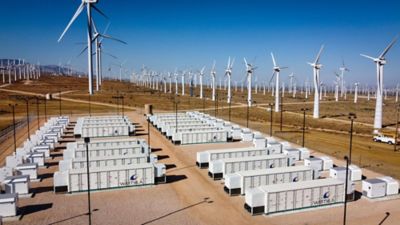-
-
Access Free Student Software
Ansys empowers the next generation of engineers
Students get free access to world-class simulation software.
-
Connect with Ansys Now!
Design your future
Connect with Ansys to explore how simulation can power your next breakthrough.
Countries & Regions
Free Trials
Products & Services
Learn
About
Back
Products & Services
Back
Learn
Ansys empowers the next generation of engineers
Students get free access to world-class simulation software.
Back
About
Design your future
Connect with Ansys to explore how simulation can power your next breakthrough.
Free Trials
ANSYS BLOG
April 15, 2022
Going with the Flow: Ansys Helps Wärtsilä Energy Powershift Toward a Sustainable Future
Renewable energy production depends on cooperation from the environment. There are natural forces at play with wind, solar, and hydropower delivery. But what happens when the sun stops shining, the wind stops blowing, or the water stops flowing? The answer rests with the energy that’s left behind. Fortunately, not all of the renewable energy produced from renewable sources is needed or used the moment it is harvested.
So, where does all this excess energy go? In the case of solar, wind, or hydropower, given ever-changing environment dynamics, the output is clearly not consistent enough and risks energy loss. Powershifting is needed to maintain a steady stream of energy to the grid. With the help of an integrated energy storage system, any downtime in energy production can be compensated for in the banking of excess output collected during peak periods of energy harvesting that would otherwise go unused.
Ansys solutions enable Wärtsilä Energy, a leader in the transition to a 100% renewable energy future, to simulate and build GridSolv Quantum — optimized by their GEMS Digital Energy Platform — a low-maintenance, fully integrated, shelf-ready storage system. It has a 20-year design life and delivers high energy efficiency to help keep the power flowing.
Designed with Sustainable Energy Optimization in Mind
Wärtsilä, headquartered in Helsinki, Finland, develops market-leading technologies and lifecycle solutions for the marine and energy markets. They specifically designed their fully integrated energy storage system for ease of deployment and sustainable energy optimization for use across solar, wind farm, and power plant applications. Components are pre-assembled and shipped to the customer site for immediate use. Each energy storage unit consists of hardware such as battery cells, cooling and fire suppression systems, containers, and inverters or power conditioners, plus the software needed to regulate them. Excess harvested energy is captured and stored for future use within the system using lithium-ion batteries.
Customers interested in energy storage systems are generally focused on stability and reliability, including actual operation costs, the rate of battery charge and discharge, and their susceptibility to degradation — all of which can be answered using simulation software. Designing an entirely new energy storage system to meet these expectations requires a complex system model that can simulate and capture the thermoelectric and electrochemical behavior of the battery, along with the complicated transient heat transfer between multiple system components. The model must accurately predict battery module temperature change in transient analysis — the calculation of a circuit’s response over a defined time period. Successful simulation depends on seamless data exchange between the system model and a unique software environment.
To build a system model to meet their objectives, Wärtsilä set out to accomplish a number of goals using simulation, including:
- Looking to battery performance data to build a battery cell model based on an electric circuit model (ECM).
- Creating a chiller model to determine power consumption and cooling capacity based on battery and coolant temperature.
- Generating and validating a reduced order model from a computational fluid dynamics (CFD) model of the cold plate to align system accuracy and computational speed.
- Combining ECM and reduced-order models (ROMs) into a battery module to understand state of charge as a function of various factors, and to control battery charge and discharge rates.
- Combining model components to create an accurate battery storage system model for testing and validation.
“As an engineer, you always question what the system margins are to boost customer confidence,” said Dewei Guan, product development engineer at Wärtsilä. “All these questions you’re not able to solve with a hand calculation or a simple model — you have to couple these multiphysics problems together with the system model. We have to use multiphysics simulation software to answer these questions and solve very specific problems for our customers.”

Taking Charge of System Performance with Simulation
Simulation enables the team to deliver an accurate, reliable model of the storage system that can test and validate the overall system performance over the life of the battery. Ansys solutions help Wärtsilä easily predict what is going to happen over the next five years. The simulation software provides intuitive, user-friendly tools that address system development and validation from every perspective. Wärtsilä used Ansys’ comprehensive set of solvers at every stage during validation of their storage system, whether working at the system level or capturing a specific electrical response. Ansys Twin Builder’s reduce order model (ROM) technology also enabled a significant reduction in overall simulation time — from one day to 10 minutes with a high-fidelity representation of the CFD model, resulting in faster product development.
“We do everything inside Ansys because Ansys basically has a tool for every engineering perspective,” said Guan. “For instance, Ansys SpaceClaim is a very user-friendly, intuitive way to create our basic model. We can then transfer this CFD model of the results from Ansys Fluent to Twin Builder to understand the thermal performance of our model. Following this workflow, we can simulate a system-level response quickly and easily.”
Spinning at the Same Frequency
Beyond interruptions in power flow, there are frequency regulation use cases — cases where the system frequency gets too high or low that can be addressed with Wärtsilä’s energy storage system. For a power plant to operate, every generator must be spinning at the same frequency to maintain overall system stability; however, it's often difficult for facilities to deliver their system response as fast as the demand change. If the supply is larger than the demand, the frequency will rise above 60 Hertz. If it is lower, it will dip below 60 Hertz.
Let’s say a power plant consistently outputs 100 megawatts of energy, but sometimes demand is 120 megawatts. When the demand is higher, frequency will reduce because the rotor in the power plant will not be able to rotate as fast as required, creating unstable conditions. Wärtsilä’s storage system is in the middle of this transaction to balance the difference between the power plant’s output and increased demand. The energy storage system responds to any differences between power generation and the demand change by either absorbing extra power via the batteries or, in this case, delivering stored power from the batteries so the frequency will remain constant.
In this scenario, successful powershifting depends on Wärtsilä’s storage system’s ability to act as an intermediary in the flow of power delivered to the grid. Guan relies on simulation data to do cell-level testing to understand the degradation of the battery cell, collect data, and then input it to predict module- or system-level behavior, or to improve on storage system design. Using surface simulation during piping development, for example, Guan and team could accelerate a new piping design, which required an evenly distributed flow to each battery module. In this instance, Fluent enabled the accurate pressure drop and flow rate prediction needed to ensure the appropriate energy flow. Ultimately this testing required just one prototype, saving six months of development time and resulting in a significant cost savings.
“Wärtsilä uses Ansys software for complex battery storage system modeling to accurately test and make predictions about the life expectancy of our energy storage systems,” said Guan. “With the help of Ansys simulation software, we were able to layer and build an accurate representation of our system that we can use to understand thermal management performance. Simulation also saved the team six months of development time and reduced the number of physical prototypes by three.”
It’s benefits like these that drive Guan’s reliance on Ansys simulation software during development, which enables quick, easy system modeling, as well as simulation of an accurate system level response.
Check out the Wärtsilä Energy case study to learn more.
